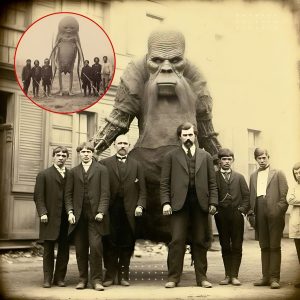WATCH VIDEO BELOW ???
Unveiling the Unbelievable: Discoveries That Could Redefine Our Understanding of History

History is a vast and intricate tapestry, constantly evolving as new discoveries challenge our understanding of the past. Recent revelations have introduced a series of astonishing findings that could reshape historical narratives and ignite our imaginations. From ancient giant cities to mysterious cosmic threats, these discoveries push the boundaries of what we thought we knew. Let’s dive into some of the most intriguing revelations that have surfaced recently.
1. The City of Giants: A Hidden Realm Under the Grand Canyon?

At the dawn of the 20th century, rumors began circulating about an astonishing discovery in the Grand Canyon. Allegedly, explorer G.E. Concade uncovered a massive underground city filled with giant mummies, intricate tunnels, and artifacts from ancient Egypt and other distant cultures. The claim suggests that the city, buried over 2,000 feet underground, contained weapons made of copper and mummies as tall as 9 feet. However, skepticism abounds as Concade’s existence remains unverified, and the Smithsonian is rumored to have destroyed the artifacts. Despite the lack of concrete evidence, the legend of the city of giants continues to captivate imaginations.
2. Hostile Alien Civilizations: A Threat to Humanity?
A new study by Alberto Cavallero posits a chilling theory about the existence of hostile extraterrestrial civilizations lurking within our galaxy. Cavallero suggests that four habitable planets might harbor malevolent alien societies that pose a significant threat to human survival. His research indicates that the probability of human extinction from a random asteroid collision is 100 times higher than from alien encounters. This alarming perspective raises questions about our place in the universe and the potential dangers that lie beyond our solar system.
3. Shackled Skeletons: Ancient Executions in Greece
An unsettling discovery in Greece has unearthed around 80 skeletons buried in a mass grave. These remains, found at the Fyon Delta cemetery during the construction of a new opera house in Athens, were shackled with primitive iron chains and executed. Dating from the 8th to 5th centuries BCE, these skeletons may be linked to a failed uprising. This macabre find offers a glimpse into the harsh realities of ancient justice and the brutal measures taken to maintain control.
4. Dark DNA: Unlocking the Secrets of Human Genetics
Recent breakthroughs in genetic research are uncovering extraordinary possibilities within the human genome. Scientists are exploring ancient technologies that may have influenced genetic manipulation thousands of years ago. One intriguing example is the Sumerian deity Ningishzidda, depicted with a double helix staff resembling DNA’s structure. This symbolism suggests that ancient civilizations might have had advanced knowledge of genetic science long before modern discoveries.
5. Human Waste: Revealing Ancient Population Densities
Researchers from McGill University have turned to an unconventional source for historical insights: human waste. By analyzing fecal stanol molecules preserved in sediment layers at the ancient city of Itsan in Guatemala, scientists have determined that the city existed 650 years earlier than previously thought. This innovative technique of examining organic waste provides new perspectives on historical population sizes and urban development.
6. The Lost City of Tuam: Rediscovered in the Desert
In the arid expanses of the United Arab Emirates, remnants of a city believed to be the legendary Tuam have been discovered. Known from ancient Arab texts, Tuam thrived on pearl fishing but was abandoned after a devastating plague in the 6th century CE. The discovery of these ruins offers tantalizing evidence of a once-thriving metropolis now buried beneath the sands of time.
7. The Bottomless Pit: A Mystery in Washington State
In 1997, Mel Waters captivated the public with his claims about a bottomless pit on his property in Washington State. Despite using over 80,000 feet of rope to measure its depth, Waters never reached the bottom, and anything thrown into the pit vanished without a trace. Although sightings of the pit persist, no reliable evidence supports its existence, leaving this mystery shrouded in speculation.
Conclusion
These revelations, ranging from the mythic to the mysterious, challenge our understanding of history and push the limits of scientific inquiry. As we continue to explore and investigate, our perceptions of the past will evolve, offering new insights into the complexities of human civilization and the universe. Stay tuned as we unravel more secrets that might redefine our historical narrative.





